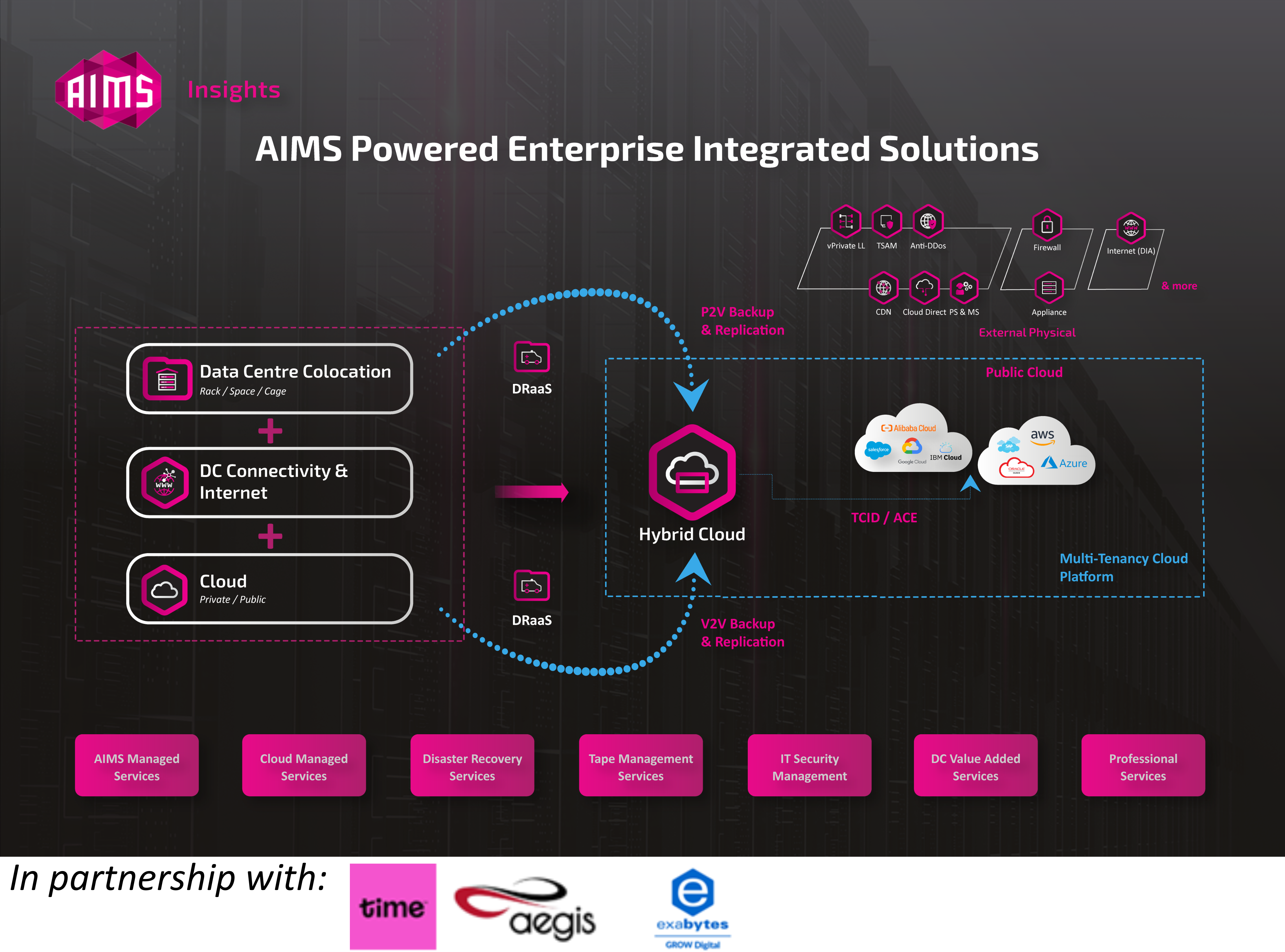Revolutionising Business Digitalisation with Data Centre Powered Managed Services

The data centre ecosystem is experiencing an ongoing period of accelerated growth. As data consumption continue to grow and demand for data management also go up across the world, data centres became the focal point for next-gen innovations, marketplace transformation, and industrial development.
As is, massive volumes of data are being rapidly generated due to the rising acceptance and quick adoption of virtualised productivity platforms and cloud computing over the last decade. Both – as digitisation enablers – have become digital economic critical drivers.

The re-emerging interest for artificial intelligence (AI), specifically Generative AI (GenAI), has also become a key contributor to the recent growth surge for data centres. According to McKinsey, GenAI demand will continue to rise and data centres are expected to meet these new usage capacities. Its new study revealed how a large chunk of these growing needs require dedicated capacity to host and manage advanced AI workloads.
When paired with wider adoption of smart devices that collect user data and constantly generate new content that is then stored and managed, these next-gen digital trends will ensure data centre demands remain supercharged for some time to come.
As user data – from personal, to business, and everything in between – continue to grow, business-related digital assets are also scaling rapidly. In fact, growing volumes had pushed operational databases to set new record-breaking milestones. According to Business Research Insights, large volumes of data – comprising system and operational data that have been generated, stored, and managed on a daily basis – are seeing significant growth rates.
One of its recent industry reports had projected the market size for database volumes growing from US$47 billion in 2023 to an estimated US$62 billion by 2032. This is due to the rapid digitisation of various industries and increasing need for real-time data processing.
Beyond ongoing efforts to deploy new digital solutions that accelerate transformative processes in business operations, managing operational databases have also become critical for many data-driven and high-performance industries. These include the banking and financial services sector – comprising fintech, banktech, and insurtech; healthcare and health management; heavy industries, like manufacturing and logistics; and digital retail.
To meet this explosive increase, vendors and corporations in the technology sector, including those leading Big Tech, are looking to upgrade and expand their data centre capacities. Beyond that, there also massive plans to build new infrastructure across the Asia Pacific.
Next-Gen Digital Services
As the data economy is now recognised as a critical growth driver, there is a clear need to focus on powering and accelerating digital transformation across all business verticals.
Malaysia started its journey on this path to growth and pushed hard to quickly grow its digital economy. In fact, it is now at the crux of reaching a new milestone of growth through the recent investments for data centres from Big Tech that have been announced over the last 18 months. While considered initially as spillovers from restrictive controls for data centre expansion for its neighbours, these new data centre deployments into Malaysia had encouraged many others to consider a similar move.
These latest turn of events for the data centre sector, which have been impactful to Malaysia’s digital economy, have become critical drivers for economic growth. More importantly, these investments provide enough supply on the infrastructure side to address the rising demand for data consumption and processing capacities.
Beyond the Big Tech push and government driven initiatives that drive forward the digital economy, various digital solutions that focus on helping businesses start and accelerate their digitalisation journey are now critical enablers as well.
Solution providers have collectively taken to call this rapidly expanding market segment as “Managed Services”.
With digitalisation now trending and powering socio-economic growth, businesses will need to consider what they should invest in to streamline and optimise their operations. This includes weighing on the best options for data management and storage policies, talent management, and planning future scalability. These points of consideration are still necessary even when businesses subscribe to self-service licensing plans with Big Tech.
Rolling out Managed Services with integrated solutions vendors (ISVs) is another option that can be considered as businesses only need to plan on where they need to store their operational data. This can be deployed as off-premise, cloud-based, or hybrid, so long as business decisions are aligned to data regulatory requirements and governance.
Beyond these two options, data centre service providers – due to their comprehensive and highly supportive tech ecosystems – can also help businesses digitise as they offer end-to-end solutions that run on large computing capacity and advanced management capabilities. These data centre powered Managed Services can deliver:
- Advanced innovations that deliver zero downtime and high-performance functions
- Built-in data centre management tools and features
- Comprehensive cyber-security and data recovery services
- Diverse network infrastructure and next-gen innovations
- Enhanced monitoring and licensing management controls
All these features that Managed Services offer focus on optimising operational functions. In terms of next-gen innovations, there are data centre stalwarts like Malaysia-based AIMS, who had developed digital platforms that provide specialised operational functions.

What AIMS specifically developed, called AIMS Enterprise Integrated Solutions that consists of AIMS Cloud Exchange (ACE) , DC Inter-Connect, and Campus Cross Connect – all three are focused primarily on delivering maximum uptime and true business continuity. With the former, it provides a direct connection between hybrid solutions – physical colocation and cloud platforms – to support seamless connectivity and instantaneous processing of data. As for the other two, they are dedicated advanced network infrastructure that link up multiple data centre campuses and bridges those that are within close proximity of each other. These functions establish an uninterrupted connection with high availability and redundancy that provide comprehensive support and backup capabilities to ensure there is no loss of operational continuity.
Having these proprietary innovations enabled AIMS to offer a comprehensive integrated solutions that offer inter-connectivity between its data centres and operating stacks. When deployed, these innovations not only provide advanced network functions and connection capabilities, they also come with advanced disaster recovery, data redundancy, and backup features. All these focus on delivering zero downtime performance for business operations.
These innovations that AIMS developed and deployed are some of examples of advanced solutions that power next-gen data centre functions that focus on empowering businesses. What AIMS offer, alongside other all-new innovations that are being developed across the data centre ecosystem, are designed to address continuous demands of data consumption and higher volumes of data-sets being generated.
Data Driven Development
As is, the explosive growth of data have directly impacted socio-economic development across the world. Of course, this digital economic growth trend is not limited to specific regions as there have been various accelerated digitised transformations across the world.
These can be seen in the billions of network connections and data streams that have come online to power the digital economy. A new industry report from Huawei that came out in late October 2024 – Huawei Global Digitalization Index 2024 – compiled the following 2023 key figures for global digital demands:
- 7.939 billion mobile broadband connections
- 12,548 exabytes of global data volume
- 5.768 billion smartphones in use
- 30% of energy from renewable sources
These data points have been derived from various sources, such as International Telecommunication Union (ITU), World Economic Forum, and the World Bank, and had been measured against a comprehensive research framework that Huawei developed with the International Data Corporation (IDC).
Notably, Malaysia placed within the Top 30 and being ranked sixth on the list acknowledges how it is quick in the region to be forward thinking with digitalisation. With how things have developed over the last 30 years, Malaysia is certainly on track to accelerate the digitisation of various economic growth engines and widen the impact of its digital economy. This can be seen in its continuous exploration and development of next-gen infrastructure and digital solutions that help businesses to embrace the digital economy.
What does this all mean for digital services and Managed Services as a whole?
All the ongoing digitalisation, which powered the transitioning of critical industries, economic drivers, and other various sectors that helped drive forward the digital economy, are dependent on connectivity and data. This, in turn, continues to significantly contribute to the growth of massive data-sets that need to be stored and managed. In its Digital Progress and Trends Report 2023, the World Bank noted how digital infrastructure – a pre-requisite for the adoption of digital technologies by default – scaled alongside rapid technological advancements and played a key part in catalysing the explosive growth for demand in data.
Malaysia had the same growth drivers for its digital economy and, like the rest of the world, saw a jump in demand for enterprise class solutions and business management capabilities. As businesses move to digitise and consider options that Managed Services can provide, new policies have also begun to rollout to ramp up the growth rate of the digital economy. This can be seen in the recent push for mandatory electronic invoicing and ongoing discussions to develop new AI and cloud regulatory frameworks and adoption plans.
Regulatory Revisions
With the digital economy now a major economic driver, especially for Southeast Asia as a fast-growth region, there is a clear need to update current regulations and develop new policies that properly manage the constantly changing digital landscape. More importantly, they must encourage and enable businesses to scale and accelerate through digitisation.
Creating a digital-first and industry-focused regulatory landscape is the first step forward. Malaysia also announced that there are plans to draft new power and water usage efficiency (PUE and WUE) guidelines for data centres. Additionally, it is also planning to draw up new frameworks that will drive forward the adoption of AI, power next-gen digital innovations, and accelerate Malaysia’s digitalisation efforts.
Beyond driving the digital economy forward, these new regulations and policies will also be the catalysts that drive up the adoption and deployment of Managed Services that data centres, ecosystem enablers, network providers, Big Tech, and various ISVs offer. From supporting grants and loans; to enabling operational and long-term sustainability; and ensuring maximum business continuity and improved operational efficiencies, regulatory frameworks play a crucial role in how the digital economy moves forward.
As data-sets and overall consumption of data continues to rise at a rapid rate, businesses will need to consider how they manage their data, specifically where it will be hosted in; how much protective oversight is needed to mitigate controversial and malicious content; and what data privacy measures are needed to manage, process, and protect these data pools.
This is why revisions to regulations and policies for digital platforms, the data economy, and next-gen economic drivers are necessary. When there is none to update, new regulatory frameworks must be developed to address new and upcoming industry issues and challenges that digitalisation will bring forth.
With GenAI, new cloud computing systems, and higher adoption rate of advanced network technologies and digital innovations now being big focuses for Malaysia, especially with the new digital economic frameworks being drafted, it has become a hotbed of innovation. These are clear indicators that ongoing growth for data centres will not slow down any time soon. Likewise, the business digitalisation will also continue to experience accelerated growth and will directly impact demand for Managed Services and various digital functions.